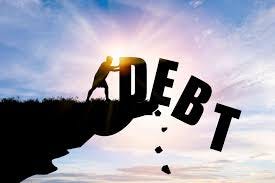My Dear Granddaughter,
In my last letter, I made the transition from talking about the giddy dread on the eve of the First World War in 1914, and a comparable—by no means identical, but comparable—sense of giddy dread at the time of your birth in 2025. My first illustration of the latter point was the man running the country on the day you were born, who has spent the last decade at the center of American life. My second illustration is something that has worried me for my entire adult life, but which has gotten sharply more worrisome: our national debt. I’m worried about it for the intrinsic dangers it poses, but also its symbolic ramifications in our society as a whole.
To start with the obvious: for nations and individuals, debt is often a very good thing. This nation could not have been founded without it (we can thank allies such as France and Holland, and the skillful diplomacy of Benjamin Franklin and John Adams for that), and I could not have been educated, and your grandmother and I could not have bought a home, without borrowing money. National debt and personal debt are of course different things that work in different ways, though one can nevertheless draw parallels between them, like personal emergencies and wartime, both of which can justify borrowing on a large scale.
There are two ways a government, or at any rate this government, has gone more deeply in debt in my lifetime. The first is by spending more money each year than it collects in tax revenue. The second is by reducing the amount of tax revenue it collects without reducing its spending. I have seen both things happen—often in tandem. The pattern first became obvious when I was a young man during the presidency of Ronald Reagan, who cut taxes but did not cut spending, in part because he didn’t want to when it came to defense and in part because he couldn’t prevent it in dealing with his opponents in Congress. With brief respites, that has been pretty much the dynamic ever since.
When Reagan was elected president, the national debt was less than $1 trillion. Twenty years later—the turn of this century—it was over $5 trillion. As I write these words, over $36 trillion—and on a vertiginous trajectory. Some of this is understandable; the global pandemic that swept the world a few years before you were born prompted this and other governments to spend large sums trying to sustain an economy that might have otherwise seized up entirely. But there was no effort to replenish the till after that crisis passed, and the old patterns of previous years proceeded afoot. Intensified, even. We’re at World War II levels of debt without a world war. Heaven help us when there is one.
Debt can be an insidious disease, Leila. It’s painless, even alluring, at the moment you contract it, and even when you can feel its bite you can live with it a long time—as long, in fact, as people are willing to lend you money. The situation is tolerable until it isn’t, and it isn’t always clear when it will cease to be.
But I’m not particularly interested in lecturing you on the economics of debt—it’s not a subject in which I’m an expert, and it’s one where I know reasonable people can disagree. I’m sure there have been times when my own debt aversion has been counterproductive, and as I write these words your grandmother is nudging us to borrow money for home improvements that may really pay off in the long run. But I think even the savviest of economists would agree that the national trajectory we’re on is problematic at best and imminently disastrous at worst.
I’m bringing all this up because I do think it’s an aspect of this giddy dread I’ve been talking about—an artifact of this moment, which while not universal, is pervasive in the culture right now. Debt can be a form of addiction, and relief of a quick fix in the form of spending can lead one from denial to fatalism: we’re doomed anyway, so we might as well get some while the getting is good. (After all, everybody else is; self-denial is a fool’s game.)
So that’s another side of this structure of feeling I’m trying to trace. I’ll get to one or two more before pivoting to my larger aim.



